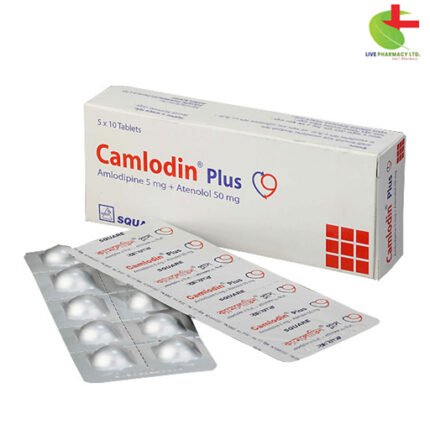Camlodin 5
75.30৳ Strip
- Camlodin: A powerful dihydropyridine calcium-channel blocker
- Provides effective relief for essential hypertension and angina pectoris
- Vasodilatory action reduces peripheral resistance, lowering blood pressure
- Enhances coronary blood flow for improved cardiac function
- Flexible dosing options allow for monotherapy or combination therapy with other cardiovascular medications
 Brand
Brand
|
Square Pharmaceuticals PLC |
|---|---|
 Generics
Generics
|
Amlodipine Besilate |
Indications
Essential Hypertension: Camlodin demonstrates efficacy as a standalone therapy for hypertension, and it can be seamlessly integrated with other antihypertensive medications for optimal management.
Angina Pectoris: Camlodin is specifically formulated to address chronic stable angina pectoris, functioning effectively both as a singular treatment and in combination with other antianginal medications.
Vasospastic Angina: Camlodin is tailored to combat confirmed or suspected vasospastic angina, offering flexibility as a monotherapy or in conjunction with other antianginal treatments.
Pharmacology
Amlodipine, the key component of Camlodin, acts as a dihydropyridine calcium-channel blocker with prolonged action, strategically designed for tackling hypertension and angina pectoris. Its mechanism involves influencing myocardial cells, specialized conducting system cells within the heart, and vascular smooth muscle cells. Upon administration, Amlodipine primarily induces vasodilation, thereby reducing peripheral resistance, blood pressure, and afterload. Additionally, it enhances coronary blood flow and triggers a reflex increase in coronary heart rate, ultimately augmenting myocardial oxygen supply and cardiac output.
Dosage & Administration
Hypertension: The recommended starting dose for hypertension management is 5 mg once daily, with a maximum dosage of 10 mg once daily. In elderly patients with hepatic insufficiency, initiation with 2.5 mg once daily is advised. This lower dose is also applicable when supplementing Amlodipine with other antihypertensive therapies.
Angina (Chronic Stable or Vasospastic): For chronic stable or vasospastic angina, the suggested dosage ranges between 5 to 10 mg, with preference for the lower dose in elderly individuals and those with hepatic insufficiency. Typically, most patients find relief with a 10 mg dose.
Administration: Camlodin can be taken irrespective of meals.
Interactions
Drug Interactions: Caution is advised regarding potentially hazardous interactions, particularly in patients with markedly impaired cardiac left ventricular function. Notably, the combination of Camlodin and β-blockers should be avoided in such cases.
Other Significant Interactions: Clinical studies have demonstrated no noteworthy interactions between Camlodin and various medications, including Digoxin, Cimetidine, and Warfarin. Additionally, food consumption does not affect the absorption rate or extent of Camlodin.
Contraindications
Camlodin should be avoided in individuals with hypersensitivity to dihydropyridine derivatives and pregnant women.
Side Effects
Common adverse effects associated with Camlodin include dizziness, flushing, headache, hypotension, and peripheral edema, attributed to its vasodilatory properties. Additional side effects may encompass gastrointestinal disturbances, increased micturition frequency, lethargy, eye pain, mental depression, and paradoxical increase in ischemic chest pain. Rash, fever, and abnormalities in liver function may also occur due to hypersensitivity reactions.
Pregnancy & Lactation
Camlodin falls under Pregnancy Category C, and its usage during pregnancy should be determined based on a careful assessment of the potential benefits versus risks. Its excretion in human milk remains unknown; thus, nursing mothers are advised to discontinue breastfeeding while on Camlodin.
Precautions & Warnings
Special precautions should be observed in patients with hepatic impairment, during pregnancy, and while breastfeeding.
Use in Special Populations
For pediatric patients aged 6 to 17 years with hypertension, the recommended starting dose is 2.5 mg once daily, which may be increased to 5 mg once daily if necessary. However, doses exceeding 5 mg daily have not been studied in this population. The effect of Amlodipine on blood pressure in children under 6 years old is yet to be determined. In elderly patients, Camlodin is well tolerated at similar doses compared to younger individuals. For patients with renal impairment, no dosage adjustments are necessary due to lack of correlation between Amlodipine plasma concentrations and renal function. In cases of mild to moderate hepatic impairment, cautious dose selection is advised, with initiation at the lowest dose (2.5 mg once daily) and slow titration. The pharmacokinetics of Camlodin have not been studied in severe hepatic impairment.
Overdose Effects
In the event of overdose, symptoms may include excessive peripheral vasodilatation and reflex tachycardia, potentially leading to marked systemic hypotension and shock. Management of clinically significant hypotension entails active cardiovascular support, such as frequent monitoring of cardiac and respiratory function, elevation of extremities, attention to circulating fluid volume and urine output, and administration of a vasoconstrictor, if appropriate. Intravenous calcium gluconate may help reverse the effects of calcium channel blockade, while gastric lavage and charcoal administration may be considered in select cases. Dialysis is unlikely to be beneficial due to Amlodipine’s high protein binding.
Therapeutic Class
Camlodin belongs to the class of calcium-channel blockers.
Storage Conditions
To ensure efficacy and safety, all medications, including Camlodin, should be stored in a cool, dry place, shielded from light, and kept out of reach of children.













Reviews
There are no reviews yet.